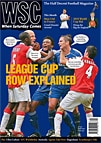 The A-League’s second season was punctuated by shocking tackles and bizarre rows, but also by huge crowds and entertaining matches. Mike Ticher believes that football is proving a success Down Under
The A-League’s second season was punctuated by shocking tackles and bizarre rows, but also by huge crowds and entertaining matches. Mike Ticher believes that football is proving a success Down Under
Say what you like about the A-League, you cannot accuse it of thinking too small. In the first season, Melbourne Victory finished seventh out of eight. Second time out they gambled on a move to the vast Telstra Dome and were rewarded with a gallop to both domestic honours in front of preposterously large crowds. On February 18 they thumped Adelaide United 6-0 in the Grand Final (having also finished top of the league) before 55,436, a record for a club game in Australia. For that they could thank five goals from Archie Thompson, a referee who looked kindly on an early characteristic lunge by Kevin Muscat and a self-destructing Adelaide team who lost their captain Ross Aloisi after a similar challenge.
The score, the crowd and the rancour all invited excessive behaviour. Kristian Sarkies became the first A-League player to kiss the Prime Minister on the head when receiving his medal, Muscat brandished the ceremonial hubcap threateningly and the Aussie Rules-obsessed Melbourne papers splashed football over their front and back pages. Adelaide’s belligerent coach John Kosmina muttered that “the dark forces of the universe etched that result in concrete before the first whistle even went”.
Rows punctuated by such apocalyptic rhetoric were everywhere. Before Sydney FC’s play-off second leg against Newcastle Jets, coach Terry Butcher unexpectedly drew inspiration in a newspaper column from the defence of Thermopylae by 300 Spartans against tens of thousands of King Xerxes’ Persians in 480BC. As it turned out Sydney were also outnumbered, after Alex Brosque was sent off, but their failure to defend as well as the Spartans ensured the match was Butcher’s last.
Butcher, Kosmina and Muscat were the emblematic figures of a highly entertaining season, which nevertheless exposed some less attractive fault lines. Butcher, taking over at last season’s champions from Pierre Littbarski, spent most of his time in shouting matches with his players and a chorus of critics who derided his blood-and-thunder approach. It was hard not to feel some sympathy for him at the pious attitude of the notoriously anglophobic Hungary-born TV commentator Les Murray, who said Butcher’s record was “a shop window for football mediocrity” and that he had been “lured here by some dimwit”.
Murray’s sidekick, former Crystal Palace midfielder Craig Foster, would call Sydney’s performances “an affront to football”. Butcher poured scorn on Foster’s credentials and insistence on “the correct style”. By that Foster means a blend of excellent technique with “traditional” Australian virtues, something he hopes will be encouraged by Dutchman Rob Baan’s appointment as national technical director and implemented by “technical”, ie non-British, coaches.
Butcher’s view might have carried more weight had he not identified Muscat as the player he would most like to sign. The old bruiser distinguished himself by scoring seven goals, but also roughed up opponents in familiar style – including Kosmina, who grabbed Muscat by the throat after he was sent flying from his pitchside chair in a comical spat in October.
The volatile Kosmina spent numerous games, including the Grand Final, banished from the sidelines. His battles with referees, coaches and the media ended with a spectacularly ungracious response to the thrashing in Melbourne. While Butcher’s aggression was pilloried as an all-too‑English trait, Kosmina’s status as a homegrown coach gave him more leeway, but not enough to excuse the Grand Final debacle. After widespread criticism, he resigned. Adelaide may have played more watchable football than Sydney, but their tactical failings in the final indicated Kosmina was not much nearer the “technical” ideal than Butcher.
Encouragingly, the debates on style have taken over from anxieties about the league’s survival. It took huge steps by capturing the Melbourne audience and putting down strong markers in Newcastle, Adelaide and Brisbane. Only the wretched New Zealand concern looks a long-term dog. The league has shown subtle signs of edging into the mainstream and rivalries are building with uncontrived nastiness. The fleeting presence or rumoured arrival of superannuated superstars was merely a sideshow (Benito Carbone and Romario made it, the latter literally at walking pace; Collymore and Zola did not).
With Asian adventures about to begin at club and international level, football should not drop entirely off the radar until the spring, when the league resumes its search for that elusive Aussie blend of grit and grace. For now we will settle for Muscat.
From WSC 242 April 2007. What was happening this month